Indian Cuisine is characterized by the use of various spices, herbs and other vegetables, and sometimes fruits grown in India and also for the widespread practice of vegetarianism in Indian society. Each family of Indian cuisine includes a wide assortment of dishes and cooking techniques. As a consequence, it varies from region to region, reflecting the varied demographics of the ethnically-diverse Indian subcontinent.
India's religious beliefs and culture have played an influential role in the evolution of its cuisine. However, cuisine across India also evolved as a result of the subcontinent's large-scale cultural interactions with ancient Greece, Persia, Mongols, and West Asia, making it a unique blend of various cuisines. The spice trade between India and Europe is often cited as the main catalyst for Europe's Age of Discovery. The colonial period introduced European cooking styles to India, adding to the flexibility and diversity of Indian cuisine. Indian cuisine has influenced cuisines across the world, especially those from Southeast Asia.
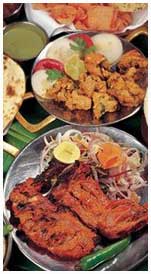 |
Punjabi |
Punjabi can be non-vegetarian or completely vegetarian. One of the main features of Punjabi cuisine is its diverse range of dishes. Home cooked and restaurant Punjabi cuisine can vary significantly, with restaurant style using large amounts of clarified butter, known locally as ghee, with liberal amounts of butter and cream with home cooked concentrating on mainly upon preparations with Whole Wheat, Rice and other ingredients flavored with masalas (spices). Roh Di Kheer, is cooked using rice. Rice is cooked for a long time in sugar cane juice.
Within the area itself, there are different preferences. People in the area of Amritsar prefer stuffed parathas and milk products. In fact, the area is well known for quality of its milk products. There are certain dishes which are exclusive to Punjab, such as Mah Di Dal and Saron Da Saag (Sarson Ka Saag). The food is tailor-made for the Punjabi lifestyle in which most of the rural folk burn up a lot of calories while working in the fields. The main masala in a Punjabi dish consists of onion, garlic and ginger. Tandoori food is a Punjabi speciality especially for non-veg dishes. Many of the most popular elements of Anglo-Indian cuisine - such as Tandoor, Naan, Pakoras and vegetable dishes with paneer - derive from the Punjab
|
| |
| Kashmiri cuisine |
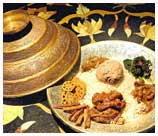 |
Kashmiri cuisine has evolved over hundreds of years. The first major influence was the food of the Kashmiri Buddhists and Pandits, the Hindus of the valley. The cuisine was then influenced by the cultures which arrived with the invasion of Kashmir by Timur from the region of modern Uzbekistan. Subsequently, it has been strongly influenced by the cuisines of Central Asian, Persia, and the North Indian plains.
The most notable ingredient in Kashmir cuisine is mutton, of which there are over 30 varieties. Also to be noted are Balti curries, popular in the United Kingdom for their exotic tastes, that were originally brought by Pakistani immigrants hailing from the Baltistan region of Pakistan-administered Kashmir. |
| |
|
| |
|
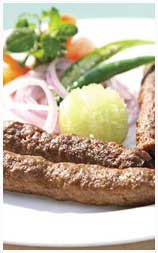 |
Awadhi Cuisine |
Awadhi Cuisine is from the city of Lucknow which is the capital of the state of Uttar Pradesh located in Central-South Asia and Northern India, and the cooking patterns of the city are similar to those of Central Asia, the Middle East, and Northern India as well. The cuisine consists of both vegetarian and non-vegetarian dishes. Awadh has been greatly influenced by Mughal cooking techniques, and the cuisine of Lucknow bears similarities to those of Kashmir, Punjab and Hyderabad; and the city is famous for its Nawabi foods.
The bawarchis and rakabdars of Awadh gave birth to the dum style of cooking or the art of cooking over a slow fire, which has become synonymous with Lucknow today. Their spread would consist of elaborate dishes like kebabs, kormas, biryani, kaliya, nahari-kulchas, zarda, sheermal, roomali rotis and warqi parathas. The richness of Awadh cuisine lies not only in the variety of cuisine but also in the ingredients used like mutton, paneer, and rich spices including cardamom and saffron. |
| |
| |
| |
Cuisine of Uttar Pradesh |
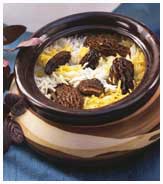 |
Cuisine of Uttar Pradesh is from the state of Uttar Pradesh located in Central-South Asia and Northern India), and the cooking patterns of the state are similar to those of Central Asia, the Middle East, and the rest of Northern India. The cuisine consists of both vegetarian and non-vegetarian dishes. Uttar Pradesh has been greatly influenced by Mughal cooking techniques. The Awadhi cuisine of Uttar Pradesh bears similarities to those of Kashmir and Punjab, and the state is famous for its Nawabi foods(of Lucknow and environs) and use of mutton, paneer, and rich spices including cardamom and saffron. Its most famous dishes include kebabs, Dum Biryani, and various Mutton recipes. The samosa and pakora, among the most popular snacks in all of India, are also originally from Uttar Pradesh. Awadhi is a type of West-Central Uttar Pradeshi cuisine found in the state's Awadh Region. Mughlai cuisine is also integral to Western and Central Uttar Pradesh's cuisine.
|
| |
|
| |
|
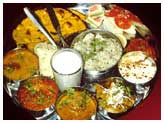 |
Rajasthani |
Rajasthani cooking was influenced by the war-like lifestyle of the Rajput and Brahmin inhabitants and the availability of ingredients in this arid region. Food that could last for several days and could be eaten without heating was preferred. Scarcity of water and fresh green vegetables have all had their effect on the cooking.Rajasthan is known for tough people and tough food.
|
| |
| Bhojpuri |
 |
Bhojpuri cuisine is a style of food preparation common amongst the Bhojpuri people living in Bihar.
Bhojpuris are fond of spicy foods and their cuisines reflect this.
The food is tailor made for Bhojpuri lifestyle in which the rural folk burn up a lot of calories in the fields.
Bhojpuri people take pride in celebrating various festivals and practices various religious rites, and as a result, their food resembles the delicacies offered to gods and goddesses. |
| |
|
| |
|
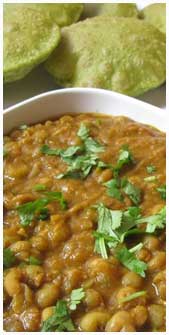 |
Bihari cuisine |
Bihari cuisine is eaten mainly in Bihar, Eastern Uttar Pradesh, Pakistan, Bangladesh, Nepal, Mauritius, Fiji, Guyana, and Trinidad and Tobago as these are they places where presence. Bihari cuisine is predominantly vegetarian because traditional Bihar society influenced by Buddhist and Hindu values of non-violence did not eat eggs, chicken, fish and other animal products. However there is also a tradition of meat-eating and fish dishes are especially common due to the number of rivers in Bihar such as the Sone, Gandak and the Ganges. There are also numerous Bihari meat dishes with chicken and mutton being the most common.
Dairy products are consumed frequently throughout the year, with common foods including yoghurt known as dahi and also buttermilk known as mattha, ghee, lassi and butter. The cuisine of Bihar is similar to a great extent to North Indian cuisine but has an influence from other East Indian Cuisine (for example like Bengali cuisine, Mustard oil is used in cooking). It is highly seasonal, with watery foods such as watermelon and Sherbet made of pulp of the wood-apple fruit being consumed mainly in the summer months and dry foods, preparations made of sesame seeds,poppy seeds in the winter months.
Some dishes which Bihar is famous for, include Sattu Paratha, which are parathas stuffed with fried chickpea flour, Chokha (spicy mashed potatoes), Fish curry and Bihari Kebab,Postaa-dana kaa halwaa. |
| |
| |
| |
|
| |
Assamese cuisine |
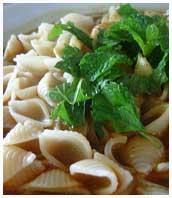 |
Assamese cuisine is the cuisine of Assam, a state in North-East India. It is a mixture of different indigenous styles with considerable regional variations and some external influences. It is characterized by very little use of spices but strong flavors due mainly to the use of endemic exotic herbs, fruits and vegetables that are either fresh, dried or fermented. Fish is widely used, and birds like duck, pigeon etc. are very popular. Preparations are rarely elaborate—the practice of Bhuna, the gentle frying of spices before the addition of the main ingredients so common in Indian cooking, is absent in the cuisine of Assam.
A traditional meal in Assam begins with a khar, a class of dishes named after the main ingredient, and ends with a tenga, a sour dish. These two dishes characterize a traditional meal in Assam. The food is usually served in bell metal utensils made by an indigenous community called Mariya. Tamul (betel nut, generally raw) and paan generally concludes the meal generally concludes the meal |
| |
|
| |
|
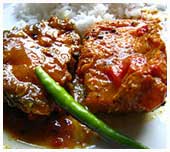 |
Bengali cuisine |
Bengali cuisine is a style of food preparation originating in Bengal, a region in the eastern South Asia which is now divided between the Indian states of Tripura, Barak Valley of Assam and West Bengal and the independent country of Bangladesh. With an emphasis on fish and lentils served with rice as a staple diet, Bengali cuisine is known for its subtle flavours, its confectioneries and desserts, and has perhaps the only multi-course tradition from India that is analogous with the likes of French and Italian cuisine in structure. |
| |
| |
| |
Oriya cuisine |
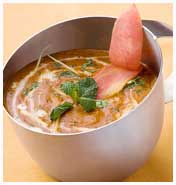 |
Oriya cuisine refers to the cooking of the eastern Indian state of Orissa. Foods from this area are rich and varied, while relying heavily on local ingredients. The flavors are usually subtle and delicately spiced, quite unlike the fiery curries typically associated with Indian cuisine. Fish and other seafood such as crab and shrimp are very popular. Chicken and mutton are also consumed. Only 6% of the population of Orissa is vegetarian, and this is reflected in its cuisine. Panch phutana & saga bhaja, a mix of cumin, mustard, fennel, fenugreek and kalonji (nigella) is widely used for tempering vegetables and dals, while garam masala (curry powder) and haladi (turmeric) are commonly used for non-vegetarian curries. Dahi Pakhala, a dish made of rice, water, and yoghurt, that is fermented overnight, is very popular in summer, particularly in the rural areas. Oriyas are very fond of sweets and no Oriya repast is considered complete without some dessert at the end.
|
|